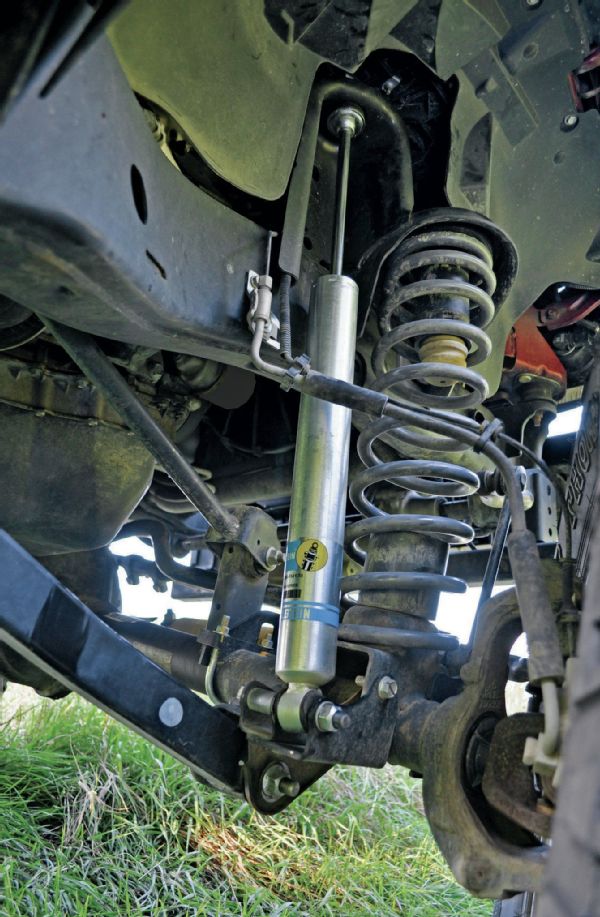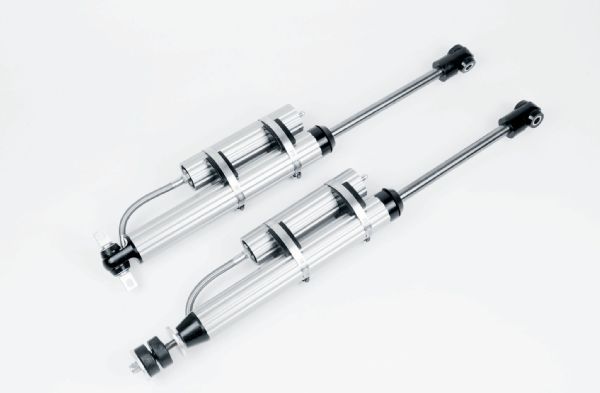
They come together in suspension kits. They go hand in hand. But do you know what springs and shocks really do and what characteristics for each that you’re looking for? Usually these aren’t things you care about unless you’re doing a custom suspension and ordering springs and shocks separately or there isn’t an off-the-shelf lift kit for what you’re doing. But even for common vehicles, understanding the job of each of these suspension components can help you diagnose suspensions issues or optimize a suspension for your vehicle and how you use it.
Springs
The springs are the foundation of a suspension system. They are what allow the up and down movement of the wheels with minimal impact on the chassis and the rest of the vehicle. The primary job of springs, though, is to hold up the weight the vehicle and its cargo.
The most common measurement of a spring for an off-road vehicle is its rate, typically expressed in pounds per inch (lbs/in). In simplest terms, this tells you how many pounds it takes to compress the spring one inch. Spring frequency is the other measurement of springs, but you rarely see aftermarket springs with a frequency rating, so it’s not as useful for us.
 Getting the correct shock and spring combination to provide the desired control and ride quality you want can be tricky business. Understanding what the key job of the spring, as well as the shock, in a suspension system is the first step. Most lift kits come with some combination that the manufacturer feels is matched. In this case, AEV Conversions provides custom-tuned Bilstein 5100 shocks with its Nth Degree suspension system for JKs.
Getting the correct shock and spring combination to provide the desired control and ride quality you want can be tricky business. Understanding what the key job of the spring, as well as the shock, in a suspension system is the first step. Most lift kits come with some combination that the manufacturer feels is matched. In this case, AEV Conversions provides custom-tuned Bilstein 5100 shocks with its Nth Degree suspension system for JKs.
As the spring rate increases (higher numerically), the more weight it takes to compress the spring, and thus the more weight the spring can hold up. Spring rates can vary greatly for the same application and the same amount of lift. For example, YJ front spring rates can range from 165 lbs/in to 300 lbs/in. A higher spring rate does not necessarily mean that it will add any height, and in most cases, it won’t. It’s there to handle more weight. However, using a spring with a much higher rate than needed will contribute to a harsh ride, and using one with a rate that is lower than needed will result in the spring being partially compressed at ride height. The latter situation will reduce ride height (that’s why your 4-inch lift spring only added 3 inches of lift to your Jeep), and the spring isn’t designed to manage the weight so it will compress more easily, leading to excessive and abrupt contact with the bumpstop.
Spring rate is primarily dictated by thickness of steel used for the spring. For coil springs, the thicker the diameter of the coil, the higher the rate. And the thicker the individual leafs in leaf spring pack, the higher the rate. The type of steel also impacts the spring rate, but using anything exotic isn’t common in lift springs.
The best way to order springs is to know the vehicle’s weight. Ideally, you’ll be able to use a set of racing scales to measure the weight at each individual corner. That’s not likely, though, so a cost-effective way to get sufficient weight info is to go to a landscape supply yard and use their scale. You’ll want the total weight and then measure just the front and then the rear. This info, combined with the desired installed height, will be enough to have a high-quality spring manufacturer create some springs that are exactly what you need.
PhotosView SlideshowShocks
While the tech behind springs is relatively straightforward, understanding shocks is more challenging. This is because most of the voodoo of how a shock works is hidden inside the tube. Also, most shock manufacturers won’t share their valving specifications. Getting the best shocks for your application may mean ordering them from companies who will build them specifically to meet your specs or by sorting through the off-the-shelf offerings to find something that comes close. Another option is an adjustable shock, but even with these you have to be close with valving to start with or it will never be optimized.
 Rock Krawler RRD external bypass shocks provide more volume for better heat dissipation, which the fluted aluminum bodies also help with, and the ability to offer a broader range of valving. The company custom builds every shock it sells, and the customer can get one revalving for free if they aren’t happy with the performance.
Rock Krawler RRD external bypass shocks provide more volume for better heat dissipation, which the fluted aluminum bodies also help with, and the ability to offer a broader range of valving. The company custom builds every shock it sells, and the customer can get one revalving for free if they aren’t happy with the performance.
The most important thing to remember, though, is that shocks do not hold weight. The purpose of the shock is to control or dampen the motion of the spring. If you’ve ever driven a vehicle with completely worn-out shocks, you know that the body of the car will keep going up and down for a very long time after hitting a bump. A high-quality shock will bring the motion of the spring back to ride height in one oscillation.
Shocks are essentially hydraulic pumps. A piston is attached to the shock rod. As the shock compresses and extends, this piston moves up and down inside hydraulic fluid. Orifices in the piston dictate how easily the piston moves by varying how much fluid is allowed to transfer from one part of the chamber to another. This converts the kinetic energy of the spring into heat, which is then dissipated through the shock fluid. The variables that affect how much dampening there is are the volume of the chambers, the diameter of the piston, the size of the orifices, and the type of fluid and gas used. And that’s in the simplest design. Most shock manufacturers in our market have advanced piston design with progressive valving that allows different flow rates at high velocity (hitting a big bump at high vehicle speed) compared to slow velocity (a small bump at slow speed).
Shocks can be either twin-tube or monotube design. Twin-tube shocks hold the hydraulic oil and gas (usually nitrogen) in the same chamber. As the name implies, there are two tubes, and the mixture of fluid and gas moves from one into the other as the piston moves up and down. These are simple, lower-cost shocks. One drawback is that they can overheat when used in heavy vehicles or ones with very heavy axles and tires. There are gas-charged versions of twin-tube shocks that have a small chamber filled with low-pressure nitrogen gas to minimize aeration, reducing overheating issues.
 If you take one thing away from this article, it should be that knowing the weight of your vehicle at the front and rear axle and working with spring and shock manufacturers who can make custom components for your vehicle and how you use it will result in the best combination of off-road performance and on-road ride quality.
If you take one thing away from this article, it should be that knowing the weight of your vehicle at the front and rear axle and working with spring and shock manufacturers who can make custom components for your vehicle and how you use it will result in the best combination of off-road performance and on-road ride quality.
Monotube shocks are considered high-performance. They separate the hydraulic fluid from the gas, significantly reducing the opportunity for aeration. They do this by introducing a floating piston in addition to the piston attached to the shock rod. The gas charge under the floating piston is at high pressure.
A variation of the monotube shock that is very popular for off-roading is one with a remote reservoir. This locates the gas charge and floating piston in a separate canister. This provides more capacity for fluid and gas for better heat dissipation and the potential for different tuning options.
Within each of these designs, the tech that sets one shock apart from another is the specific valving. Custom shock builders can configure the valving for the weight of your vehicle, the weight of the axle, wheels and tires (unsprung weight), and how you use the vehicle. High-speed desert racing requires much more attention to shock tuning than rock crawling does.
PhotosView Slideshow





